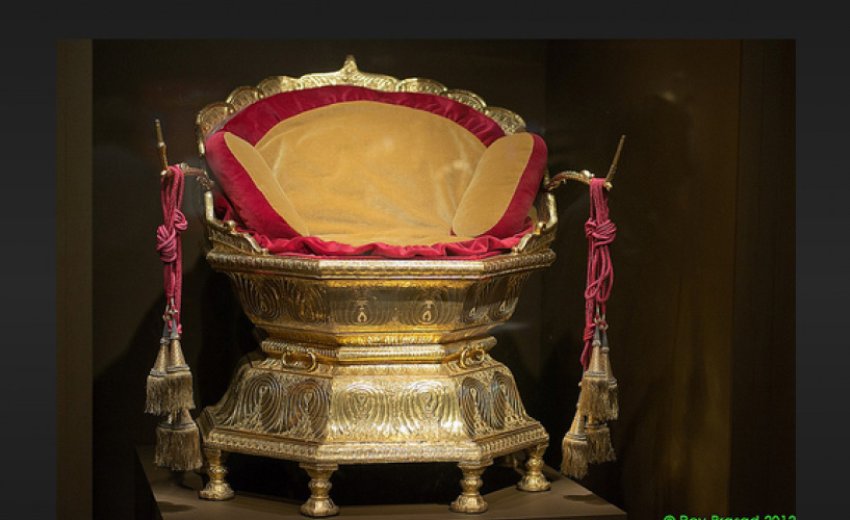One of the most iconic symbols of Ranjit Singh's kingdom is the golden throne, now securely housed in London's V&A museum. This exquisite artefact holds a permanent place within the museum's collection, standing out as one of its most significant treasures. In the upcoming months, the Golden Throne will play a pivotal role in the splendid Maharaja exhibition running from October to December, after which it will embark on a tour to Germany and Canada.
A glimpse at the throne
The privilege of closely examining the throne outside its usual glass enclosure was recently granted to an individual. They graciously present some of the remarkable pictures taken by Jasprit Singh and delve into its intriguing history here, on Punjab Heritage News.
Observing the throne up close is an extraordinary experience, and the very existence of this magnificent artefact is a testament to its miraculous preservation. The Sikh community, relatively young in comparison to many others, has regrettably lost a substantial part of its historical heritage. Fortunately, institutions like the V&A in Britain are now renowned for their world-class efforts in safeguarding Sikh heritage, although the same cannot be said for their predecessors.
Historical significance
In 1849, after the annexation of the Punjab, the Toshkhana faced a raid that left the East India Company and its leader, Lord James Dalhousie, on the brink of financial ruin. For them, the royal treasury was nothing short of a lifeline, presenting a golden opportunity to repair their beleaguered finances.
Dalhousie, with the assistance of his secretary, Dr. John Login, took the initiative to meticulously inventory the treasures held within the Toshkhana. The wealth he uncovered left Dr Login awestruck, as he marvelled at the vast quantities of gold, silver, priceless jewels, and an immense collection of opulent Cashmere shawls meticulously stored on shelves and bundled into bales.
This inventory was not intended to preserve a rich artistic heritage or carefully document an invaluable collection for posterity. It was, in fact, a catalogue for an extravagant fire sale. Over nine exhilarating days, Dalhousie proceeded to auction off the lion's share of the treasury. The larger and bulkier items presented challenges in finding buyers, so Dalhousie decided to melt down a silver pavilion. Regrettably, the Dalhousie auctions remain a dark chapter in Sikh history, representing one of the most egregious acts of cultural malevolence.
Throne’s origins
The throne of Ranjit Singh, a truly exceptional and distinctive piece, distinguished itself amid a sea of opulent gems and finely crafted weapons. At first, Lord Dalhousie sought to claim the throne for himself, expressing to the British Government,‘It is set apart as an object which the court would probably desire to preserve, but as it is bulky, I shall not forward it until I receive orders to do so’. However, his intentions were transparent to the government, which insisted that the throne, along with other invaluable treasures like the Koh-i-Noor, be sent to London. Nevertheless, before parting with it, Dalhousie had a wooden replica of the throne created for his collection.
The Golden Throne was a masterpiece crafted for Maharaja Ranjit Singh by a skilled Muslim goldsmith named Hafez Muhammad Multani, during the period spanning from 1820 to 1830. Hafez Muhammad adorned thick layers of pure gold with an exquisite design featuring blooming flora, concealing the throne's wooden core.
Hafez Muhammad held a prominent position as a goldsmith in the Lahore court, as his name appeared twice in the meticulous inventories of the treasury when the East India Company annexed the Panjab and Sikh crown property in 1849. Subsequently, the Golden Throne was transported to the Indian Museum in London, and in 1879, it found its permanent home in the South Kensington Museum, later known as the Victoria and Albert Museum.
Looking at the marvel closely
The execution of the throne is truly breathtaking. It features a wooden substructure covered in intricately crafted solid gold sheets with rich, symbolic decorations. Shaped like an opening lotus flower, the throne draws inspiration from Sikh scripture, urging individuals to live in the world like the lotus in murky waters, free from worldly attachments. This motif repeats around the base, making Ranjit Singh, seated in the throne during his public durbars, a dazzling presence, both as a maharaja and a religious icon.
Upon closer inspection, the throne's intricate details become evident. Even for those familiar with it, like the narrator who has seen it numerous times in the museum, the opulence of the work on the back of the throne still strikes a chord, even though it is sadly not very visible in the current display case.
In preparation for the Maharaja exhibition, the throne underwent meticulous cleaning in the conservation department, led by Diana Heath, the head of metalwork conservation at the V&A. The precision and professionalism of conservation experts always impress, and Diana's work involved carefully removing ten years' worth of light dust without disturbing the 200-year-old patina that defines the throne – a notable departure from the heavy-handed re-gilding of the Harimandir Sahib in 1999. The hope is that, after its exhibition and worldwide tour as part of the Maharaja's exhibition, the throne will return to public display, allowing every visitor to appreciate the masterpiece that is Ranjit Singh's Golden Throne.
*Based on an article by Amandeep Madra, published on 20th October 2009
